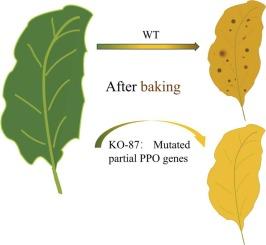烟草多酚氧化酶(PPO)基因家族的全基因组特征及K326烟叶褐变反应的分子改良
IF 6.2
1区 农林科学
Q1 AGRICULTURAL ENGINEERING
引用次数: 0
摘要
多酚氧化酶(PPO)能氧化多酚类物质,使烟草(Nicotiana tabacum L.)的叶子在烘烤过程中褐变,从而降低其质量和商业价值。本研究通过基因组挖掘鉴定了13个NtPPO基因,并对其进行了生物信息学分析,包括基因结构、蛋白质结构和理化性质。组织特异性表达分析发现,NtPPO基因在叶片中大量表达,而NtPPO9和NtPPO10在花中也有高表达。在叶片生长过程中,NtPPO1、3、5、6和7的表达模式发生显著变化,而NtPPO2、9、10和13的表达模式保持稳定。其中,NtPPO1在烟叶成熟期表达量最高。亚细胞定位显示,NtPPO1、6、9和12主要分布在叶绿体中。KO-87通过CRISPR/Cas9技术生成,包括NtPPO1、2、4、6、8、9、11、12和13个基因的突变。KO-87的生长与野生型相似,但烘烤后叶片中PPO活性降低,褐变水平降低。代谢组学分析表明,突变体叶片中多酚代谢物显著上调,醌代谢物显著下调。本研究系统探索了NtPPO基因的功能,初步了解了其在烟草叶片褐变过程中的关键作用。这些发现为解决烟叶烘烤过程中的褐变问题提供了新的研究方向和潜在的解决方案。本文章由计算机程序翻译,如有差异,请以英文原文为准。

Genome-wide characterization of polyphenol oxidase (PPO) gene family in tobacco and the molecular improvement of browning reaction for K326 tobacco leaves
Polyphenol oxidase (PPO) oxidizes polyphenols, causing browning in tobacco (Nicotiana tabacum L.) leaves during roasting, which reduces their quality and commercial value. In this study, 13 NtPPO genes were identified through genome mining, and their bioinformatic analyses were performed, including gene structure, protein structure, and physicochemical properties. Tissue-specific expression analysis found that the NtPPO genes were substantially expressed in leaves, whereas NtPPO9 and NtPPO10 were also highly expressed in flowers. During leaf growth, NtPPO1, 3, 5, 6, and 7 expression levels changed dramatically, whereas NtPPO2, 9, 10, and 13 expression patterns remained steady. Notably, NtPPO1 displayed the highest expression levels during the maturity stage of tobacco leaves. Subcellular localization revealed that NtPPO1, 6, 9, and 12 were primarily distributed in chloroplasts. KO-87 was generated through CRISPR/Cas9 technology, including mutations in the NtPPO1, 2, 4, 6, 8, 9, 11, 12, and 13 genes. KO-87 exhibits similar growth to the wild-type, but with decreased PPO activity in leaves and browning levels after roasting. Metabolomics analysis indicated that polyphenol metabolites were significantly upregulated, while quinone metabolites were significantly downregulated in the leaves of mutant plants. This study systematically explored the functions of NtPPO genes, providing preliminary insights into their key roles in the browning process of tobacco leaves. These findings offer new research directions and potential solutions for addressing the browning problem during tobacco leaf roasting.
求助全文
通过发布文献求助,成功后即可免费获取论文全文。
去求助
来源期刊

Industrial Crops and Products
农林科学-农业工程
CiteScore
9.50
自引率
8.50%
发文量
1518
审稿时长
43 days
期刊介绍:
Industrial Crops and Products is an International Journal publishing academic and industrial research on industrial (defined as non-food/non-feed) crops and products. Papers concern both crop-oriented and bio-based materials from crops-oriented research, and should be of interest to an international audience, hypothesis driven, and where comparisons are made statistics performed.
 求助内容:
求助内容: 应助结果提醒方式:
应助结果提醒方式:


